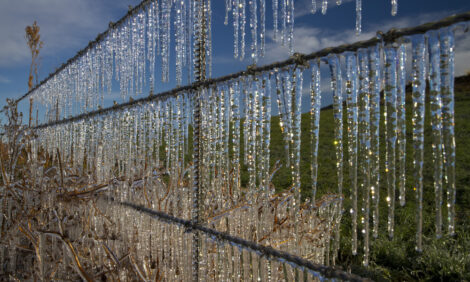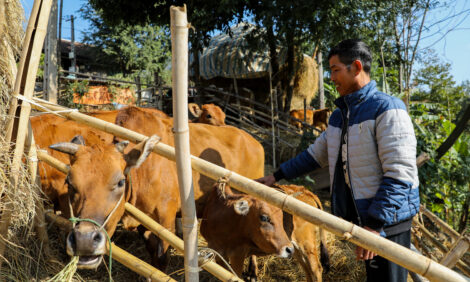



Maintaining Competitiveness with Today's High Grain Prices
The availability of cheap feed grain for many years influenced the structure of the beef cattle industry and the types of production systems used in very fundamental ways. These impacts are only just now being truly recognised as the industry struggles to adapt to an economic environment that appears to have fundamentally changed and the changes appear to be permanent, writes Derrell S. Peel, Professor of Agribusiness and Extension Livestock Marketing Specialist at Oklahoma State University.Maintaining Competitiveness with Today’s High Grain Prices
The availability of cheap feed grain for many years influenced the structure of the beef
cattle industry and the types of production systems used in very fundamental ways. These
impacts are only just now being truly recognised as the industry struggles to adapt to an
economic environment that appears to have fundamentally changed and the changes appear to be
permanent. These changes begin as direct short run impacts on the feedlot sector but ultimately
will have long impacts that will affect every aspect of cattle production.
Data from a monthly survey of Kansas feedlots demonstrates the dramatic changes that
have taken place. From January, 1990 – December, 1996 the average steer feed cost of gain
(COG) reported by feedlots was $52.82/cwt., with a standard deviation of 5.71. This means that
two-thirds of the time over this 17 year period, the COG was between $47.11/cwt and
$58.53/cwt. Corn prices jumped sharply in late 2006 and have been reflected in higher feedlot
COG since 2007.
From January, 2007 through the most recent data in October, 2011, the average COG was
$80.59/cwt., with a standard deviation of $10.14. Thus the COG has ranged from $70.14/cwt. to
$90.73/cwt. two thirds of the time over the latest 58 month period. Feedlot COG has averaged
has 53 per cent higher the last (nearly) five years compared to the previous 17 year period and has
been more volatile with a standard deviation nearly double the previous period. The lowest end
of the range of one standard deviation since 2007 has been nearly 20 per cent higher than the
highest end of the one standard deviation range of the period from 1990-2006.
The impacts have been even greater in 2011. The January to October average feedlot
COG in 2011 was $95.68/cwt. The COG was greater than $100/cwt. for the first time ever in
August of 2011 and posted an all time high to date of $106.85.cwt. in September. The October
monthly COG was reported at $106.24/cwt. While it is uncertain what corn prices and thus COG
will be in the future, it seems clear that it is likely to average significantly higher than the levels
that prevailed for many years and under which the industry evolved to operate as it does today.
The Current Cattle Market Environment
High grain prices are affecting the cattle industry as part of a varied set of market factors.
The short run impact of high grain prices can only be understood when considered against the
backdrop of a unique beef cattle market situation that has been developing for a number of years.
The most important feature of the current cattle market is low cattle inventories. Total
cattle inventories and the cow herd inventory specifically, have declined 14 of the last 16 years.
Several factors have contributed to this prolonged liquidation including drought in the early
2000s; the initial corn price shocks described above; US and global recession and most
recently, a severe drought in the Southern Plains. Notwithstanding the importance of other
market factors such as domestic beef demand and growing international beef trade, it is limited
cattle numbers, especially as reflected in small feeder supplies that explain record high prices for
feeder cattle at the current time and for the foreseeable future. With critically low cow numbers,
rebuilding of herds and feeder cattle supplies will likely take several years.
Short Run Impacts of High Grain Prices
High feed prices affect feedlots most directly and immediately. Typically, the initial
reaction of feedlots is to reduce feeder cattle prices. This happened in the first few months after
corn prices first jumped in late 2006 and early 2007 but was thwarted by the fact that limited
cattle supplies kept feedlot competition for feeder cattle keen and by the fact that the tradeoff
does not work very well if high feed prices is a long term rather than a short run situation. In
general, both feeder cattle and feed prices have continued to rise since 2007, and especially since
2009, both feeder cattle and corn have risen simultaneously to record high average levels.
The other short run response of feedlots is to minimise feed cost exposure by placing
heavier feeder cattle in the feedlot. This is the principal short run means by which the industry
reduces total feed use in the face of high feed prices. However, this effort has likewise been
limited by the number and kind of feeder cattle available. Part of the declining feeder cattle
supplies in recent years is a result of the long term tendency for feeding younger and lighter
animals than would have been typical many years ago. The industry’s evolution to calf feeding
was driven largely by cheap feeds that made feedlot gains extremely competitive to forage based
cattle gains. Since 2007, despite considerable incentive to move back to yearling based feeding
programs, feedlots have been forced to continue placing many lightweight calves simply because
of very limited supplies of heavy feeder cattle. In 2011, this situation was exacerbated by the
drought which forced the early placement of many calves. Though this helped to maintain
feedlot inventories in the short run, it runs counter to the underlying economic signals of the
feedlot industry.
High Grain Prices May Result in Structural Change in the Long Run
In addition to the short run market conditions and the responses that the feedlot industry
is making or is forced to make, the long run structure of the cattle industry will also likely
change in response to higher grain prices. Higher feedlot costs of gain increases the value of
forage based gains as the industry shifts permanently back to more of a yearling based feeding
industry. Increased value of forage based gains is a signal for stocker and backgrounders to take
a bigger role in the total production of cattle by utilising more forage prior to feedlot finishing.
This is already being reflected in feeder cattle price relationships that put more value on stocker based gains in total and more value on gains at higher weights, specifically. In the coming years,
as feeder supplies begin to grow, there will be even more tendency for feedlots to routinely place
heavier cattle and for stocker producers to put that additional weight on feeder cattle in stocker
and backgrounding programs. This is likely to lead to several changes in cattle markets:
Marketing of heavier feeder cattle. Typical feedlot placement weights may increase 100-300
pounds and become much more common with market prices showing little discount on feeder
cattle up to much heavier weights.
Changing seasonal feeder price patterns. Over the past twenty years, feeder prices have
changed such that prices tend to be highest in the middle of the year compared to previous
periods where feeder prices tended to peak in the spring and be lower in the second half of the
year. These recent seasonal price patterns were a reflection of the orientation of the industry to
calf feeding and as the industry reverts back to a more yearling based feeding structure, seasonal
prices will likely revert also to reflect seasonal forage production with more spring price peaks.
More fundamentally, the industry will look for ways to fundamentally reduce grain use in
cattle production. Over the past 40 to 50 years, the industry has greatly enhanced production and
efficiency of grain-intensive production systems as a result of the market incentives embodied in
cheap grains. Now the incentives have changed; the question is not “how to get cattle to eat
more grain?” but rather “how to produce high quality beef using the least amount of grain?”.
This implies many new questions and ways of thinking about cattle production as relatively more
forage intensive and less grain intensive.
Many of the new questions do not have answers yet and it will take many years for the
industry and the research that supports it to see what the potential really is. Remember that it
took 30 plus years for the potential of grain intensive production to be realised and this change
will be no different. It is likely that cattle production in the future will value some animal
genetics differently than in the past; that the types and applications of some technologies may
change and many other production factors may change according to new incentives. Increased
forage value places a new emphasis on the use and management of forages for increased
productivity and efficiency and there will be more efforts to identify new forages and forage
systems for use in cattle production.
High crop values have implications for land use and particularly for the location of forage
production (and cattle production) over time. Land use patterns, particularly for perennial crops
like hay and pasture, tend to adjust slowly and it will take many years for the changes to be fully
realised. However, some changes are already becoming evident. Compared to 2006, harvested
hay acres in the US is down 5.5 per cent in 2011. This reflects the general response to high corn
prices as more acres are used for corn production with acreage of most other crops down over the
period. The change is more dramatic in the key corn production areas of Illinois, Indiana, Iowa,
Nebraska and Missouri where hay harvested acres in 2011 is down 12.4 per cent compared to
2006. This amounts to 1.22 million of the total 3.32 million acre decrease nationwide or 37
per cent of the total reduction. Pasture acreage is likely down in the region as well though such
changes occur slowly and it will be some time before data is available to confirm the changes. In
general, the agricultural market situation tends to favor less hay and pasture production in regions where crop production competes more for land use. This suggests a tendency for less
cow-calf production in regions such as the Midwest relative to the western Great Plains and
range areas of the West. Conversely, some cattle feeding advantage appears to have shifted
back to the Midwest relatively to the Southern Plains based, in part, on the regional availability
of by-product feeds. Purely grazing-based stocker production will be focused in the forage
regions of the plains and western US but confinement and semi-confinement backgrounding
programs may flourish in the western Corn Belt to take advantage of the interface between
seasonal grazing and the availability of by-product feeds and harvested forages.
Summary
The reality of high grain prices and other cattle markets conditions sets the stage for a very dynamic and challenging set of decisions for the next few years. Additionally, more fundamental changes in cattle production may be occurring in response to permanently different market incentives in the future. It has often been said that the beef industry has better ability to cope long term with high grain prices than competing meat industries. That statement is true but carries huge implications for structural change in the industry. The flexibility that beef cattle have relative to monogastric species is an advantage in the face of high grain prices only if the industry makes the changes it is capable of making. In order for the beef industry to maintain the maximum degree of competitiveness in the face of high grain prices, the industry must become less grain intensive and more forage intensive which implies changes not only in the feedlot sector but also in the stocker and cow-calf sectors as well.
June 2012

